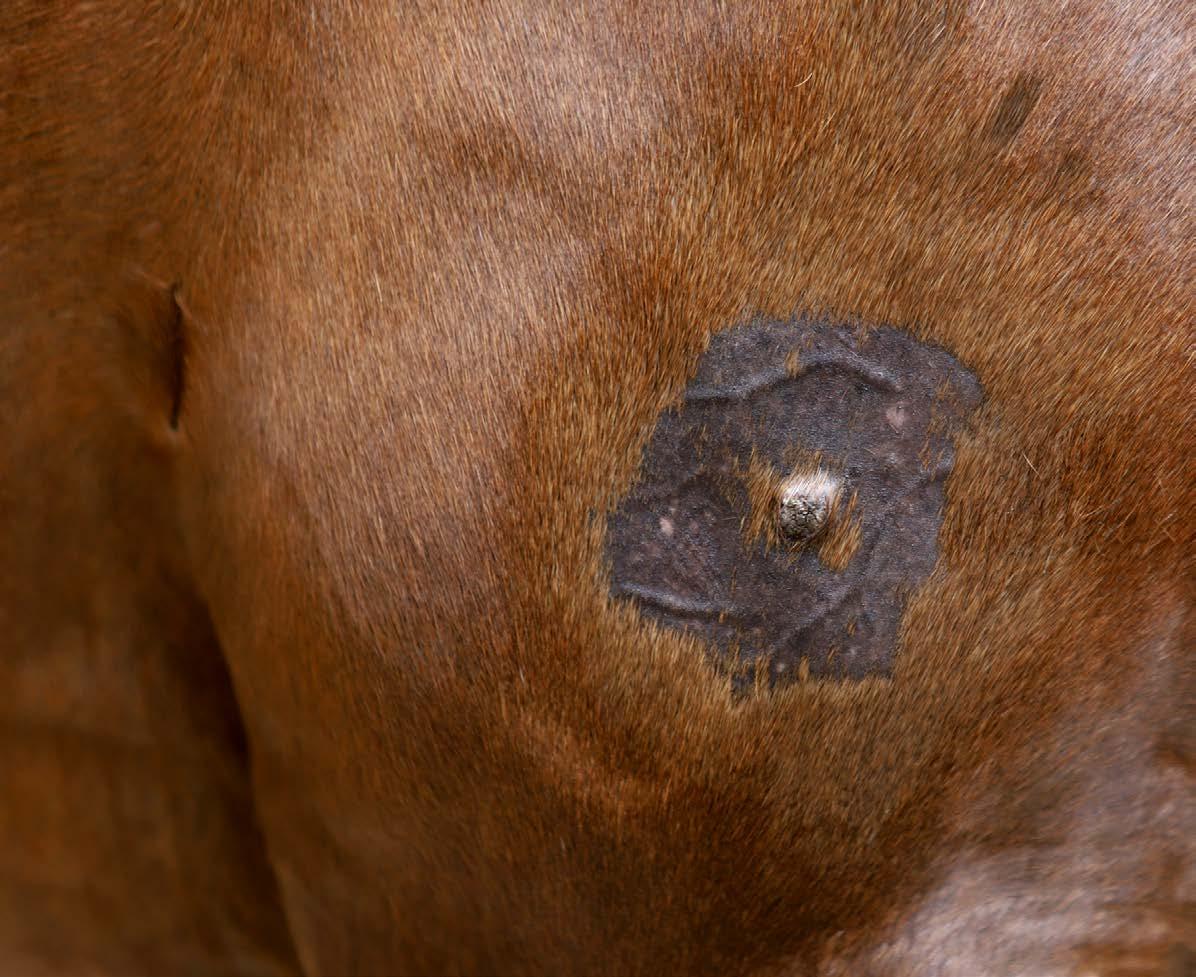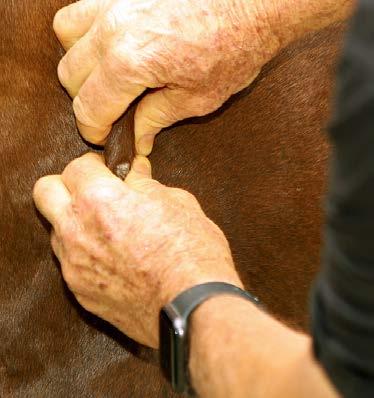
7 minute read
Vet Vibes: Sarcoids
A small well-defined sarcoid with a wide margin of unaffected skin.
VET VIBES Equine sarcoids: what you need to know
Advertisement
If you’ve noticed a wart-like lump on your horse’s skin, it could very well be a sarcoid. Veterinarian Dr DOUG ENGLISH discusses types and treatments.
The equine sarcoid is by far the most common cutaneous neoplasm (skin growth) in horses. It affects horses of all ages, and was first described by Jackson in 1936. He introduced the term ‘equine sarcoid’ because the growth looked like a sarcoma, which is a cancer of the connective tissue.
An equine sarcoid is a tumour of the skin only, it does not spread to internal organs. Most affected horses are normal in every other aspect except those with large lesions. A sarcoid doesn’t seem to have any significant correlation with age, sex, or breed, and incidence varies between two to six per cent of the equine population, including donkeys, mules, and zebras.

are most likely the primary cause of sarcoids. BPVs are spread by flies from any lesion to any wound, even one that’s small and barely noticeable. Your horse doesn’t have to be in close proximity to cattle for spread to occur, because flies can be blown around over distances of many kilometres. Types of sarcoids There are six broad types of sarcoids. While most are slow growing, all types have a high propensity for recurrence and often interference or injury can make them change to a more aggressive type. With such a tendency for change, most vets are reluctant to use a biopsy to define them because of the risk of activating the sarcoid and it becoming Sarcoids can appear on anywhere on the body (Image by Alexandra Beckstett). more aggressive. Most are recognisable by observation anyway, and any warty growth that has been present long term is going to be a sarcoid – and that’s true in almost 100 per cent of cases. To determine whether or not the growth is a sarcoid, a good size sample is needed from centre of lesion to achieve an accurate result. A needle biopsy is not worth doing. The six types of sarcoids are as follows (keeping in mind that any type can unpredictably change to another): 1. Occult: small circular hairless skin spots 2.Verrucous: warty and scaly 3.Nodular: large spherical nodules 4.Fibroblastic: fleshy with
Examining a sarcoid prior to

removal.
After cleansing around the general area, a local anaesthetic ensures the

procedure is painless. prominent ulceration 5.Mixed: types two, three, and four all combined 6.Malignant: an extreme form with deep local tissue invasion
(Prof Derek Knottenbelt, University of Liverpool). Treating a sarcoid No single treatment is consistently effective and recurrence is always possible. There are many treatment options, with no standout success achieved with any of them - radiation possibly being the best. That a few cases do resolve spontaneously does imply that there may be some immunological processes involved.
• Surgical incision: Only suitable for small well-defined lesions where there are wide margins of unaffected
skin around the sarcoid. A good first choice for sarcoids of this type, I try to seal the edges with Superglue after suturing to protect the wound and wall off flies. Laser excision with a CO2 laser is better than a scalpel, but the equipment is very expensive and very few vets have a laser. I would love to own one.
• Cryosurgery or freezing: A commonly used form of treatment but with poor success rates.
• Cytotoxic compounds such as Xterra and Cansema: These compounds produce extensive tissue necrosis (death of the cells) and scarring.
They’re a cheap and easy option, but messy. They’re sometimes successful, but because of the danger of the horse chewing the area and ingesting the compound, care should be taken in their use.
• Radiation: Offering the best overall results, this treatment is difficult to access. Targeted radiation requires very expensive equipment that is not, to my knowledge, available for horses in Australia. It is an option for dogs, who are anaesthetised and securely placed so they can be treated without the risk of them moving, and for humans who, of course, can be told not to move.
Radioactive gold implants work well and produce radiation continually over a period of time. I don’t know of any vet who’s licenced to access them, but some doctors use them to treat humans. Professor Dick Dickson of Sydney University was my go-to person before he died, and 30 years ago we had a lot of success. However, there is danger to the operator who must be a licenced radiology specialist, and also to the owner who must not get within a meter of the treated region for four to six weeks.
• Cisplatin: Biodegradable beads containing cisplatin and a stable emulsion of cisplatin in sesame With the sarcoid removed, Doug sutures the wound (All images courtesy of Sarah Gibson).
oil have given some very good results, but treatment requires repeated injection into the lesion. Cisplatin, a chemotherapy medication used to treat a number of cancers, is expensive as well as being a significant hazard and dangerous to humans.
• Turmeric: This treatment involves feeding turmeric powder as well as applying a mix of curcumin and tetrahydrocurcumin (the active ingredients in turmeric) dissolved in dimethyl sulfoxide (DMSO) to the affected area - or a more crude option is just to use turmeric powder. This approach has had reasonable success. It’s a process I’ve experimented with, and ongoing results are available in the Facebook group https://www. facebook.com/groups/sarcoids. Feeding turmeric powder in a quantity of one teaspoon up to a half cup along with a small amount of linseed meal is best. Start small and consider adding pepper, which slows the otherwise rapid excretion of the beneficial curcuminoids.

• Acyclovir: A weak effect but there have been some good results along with feeding turmeric. Acyclovir in a gel of a five per cent or higher concentration needs daily application over many months.
reportedly produced good results with tissue taken from the sarcoid frozen in liquid nitrogen and implanted into subcutaneous pockets in the neck. There are some trials with chimeric vaccines involving BPVs which are promising but not yet on the market. These are produced by substituting genes from the target pathogen for similar genes in a safe, but closely related organism.

• EBC46: Now called Stelfonta and developed by the Australian company
Ecobiotics, this is an excellent new product. I have used it and it works well. Now approved for use in the
US and the European Union, it will hopefully soon be available in
Australia. Stelfonta produces an immune response, enabling the body to eradicate the tumour. It’s injected into the lesion by a veterinarian (if the lesion is large much of the volume may need to be surgically removed before treatment), and further treatments might be necessary. In my experience, because curcumin also stimulates the immune system to attack viruses, Stelfonta worked better when turmeric is fed at the same time. There is a synergy between the two. For more information on Stelfonta visit https://qbiotics.com/.
• BCG vaccine: This is injected repeatedly into the lesion with varying but not great success.
One aspect to consider is that there are reports of unpredictable anaphylactic (allergic) reactions which may be fatal. Also some lesions, particularly on the legs, can become worse after treatment with BCG.
• Homeopathic: There have been varying small successes with the use of Vegemite, toothpaste, aloe vera, rosemary oil, tea tree oil, and Camrosa ointment (caution is required with this option as it can be dangerous). However, these options frequently worsen the problem, which is probably a factor of interference rather than direct effect. Occasionally but not that often, sarcoids spontaneously disappear and then whatever treatment is being used at that time will get all the credit.
And on a final note, from my near 50 year experience with sarcoids, and their various treatments and outcomes, it’s become clear that turmeric can play a significant role in the success of any treatment option. Feeding horses turmeric daily is not only helpful in the prevention of sarcoids, it’s also a great way to boost their immune systems.
For more information on the uses of turmeric, visit www.turmericlife.com.au.










